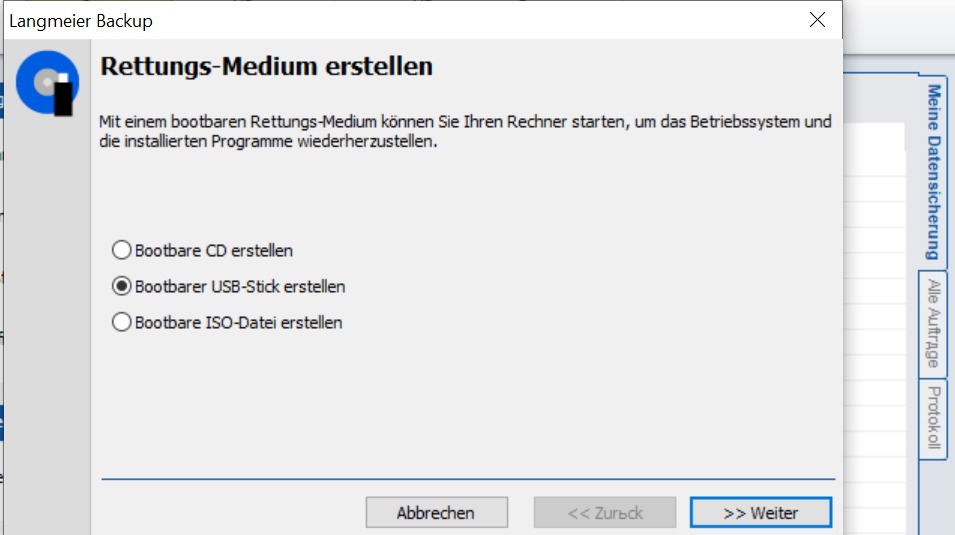Langmeier Backup
Detailed instructions: Booting Windows 11 from a USB stick
Booting Windows 11 from a USB stick can be useful in many situations, be it for testing new versions, troubleshooting or data migration. Here you can find out how to boot your computer from a USB stick using either the settings or the boot menu/BIOS.

Reasons for booting Windows 11 from a USB stick
There are several scenarios in which booting Windows 11 from a USB stick makes sense:
- Trying out a new versionYou want to test the latest version of Windows 11 without affecting your currently stable system.
- Fixing system errorsYour computer does not start properly or crashes frequently. A bootable USB stick can help you to repair or reinstall the system.
- Data transferYou want to transfer your operating system, data and settings to a new computer while keeping the same configurations.
Scenarios for booting Windows 11 from a USB stick
a. Normal operation of the computerYour computer is working properly and you can access the boot drive settings via the Windows settings.
b. Malfunction of the computerYour computer has an error and the system crashes or does not work properly. In this case, you need to access the boot menu to boot your computer in BIOS mode from a USB flash drive.
Let's now go through each method in detail.
Method 1: Start Windows 11 normally - via the settings
If your computer is working normally, you can follow the steps below to boot from a USB flash drive:
1. Connect USB flash driveInsert a bootable USB stick into a USB port on your computer.
2. open settingsPress Windows + Ito open the settings and select System > Recovery.
- Alternatively, you can search for "Recovery" in the Start menu and open the corresponding settings.
3. advanced startClick on Restart now under Advanced start. Your computer will restart.
4. select optionAfter the restart, you will be taken to the recovery menu. Select the option "Use a device" option..
5. select boot deviceSelect the USB stick from the list of available devices. The computer
will reboot from this USB stick.
Method 2: PC does not start normally - via the boot menu/BIOS(blue screen)
For example, if your computer displays a blue screen or crashes constantly, this could be due to viruses, malware, corrupted files or failed system upgrades. In such cases, you will need a bootable USB stick to restart and repair your computer correctly.
1. connect the USB stickInsert the bootable USB stick into a USB port on your computer.
2. start the PCTurn on your PC and press the corresponding button repeatedly to access the boot menu or BIOS setup. The key may vary depending on the manufacturer and model (often ESC, F2, F8, F10 or DEL).
- Check your computer manual or the manufacturer's website to determine the exact key.
3. change boot orderNavigate to the "Boot" or "Boot order" section in the BIOS setup and place the USB stick in the first position.
- In some BIOS versions, you must change the boot order by moving the USB stick up using the arrow keys.
4. save and exitPress F10 (or another displayed key) to save the changes and exit the BIOS setup. Your computer will now boot from the USB stick.
Creating the rescue medium with Langmeier Backup
To be able to boot Windows 11 from a USB stick, you must first create a bootable USB stick. You can do this easily and efficiently with the Langmeier Backup software. Here is how to proceed:
- Open Langmeier Backup on your computer.
- Go to the "Tools" tab and then click on "Create rescue medium".
- Follow the instructions on the screen to create the rescue medium on a USB stick or CD/DVD. For virtual machines, you can also create an ISO file here.
- Once the process is complete, you will have created a bootable rescue medium that you can use to restore your system.
about the author: Natalia Bobro
Chief Digital Transformation Officer
Natalia Bobro is Langmeier Software's Chief Digital Transformation Officer (CDTO) and in this role is responsible for the company's overall business development and strategy. As CDTO, Natalia Bobro focuses on positioning Langmeier Software as a leading technology company in the area of software and services.
Under Bobro's leadership, Langmeier Software focuses on a broad range of business areas, including artificial intelligence (AI) applications, cloud services and enterprise applications. It invests heavily in the development of new software products and solutions and promotes the introduction of AI & cloud services such as Cloud Backup, aBusiness Genius and aBusiness Suite.
Look it up further: Backups, Data backup, Data protection, Rescue medium, Windows 11, Data recovery
Related articles
Which type of backup is the best choice for my data?This is how important data backup is in real lifeFAT32 or NTFS? Which format is better for backups?
Post a comment here...



